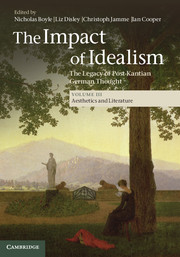Book contents
- Frontmatter
- Contents
- List of Illustrations
- List of Contributors
- Acknowledgements
- List of Abbreviations
- Introduction: Idealism in aesthetics and literature
- 1 The legacy of Idealism and the rise of academic aesthetics
- 2 Hegel's philosophical theory of action: the concept of action in Hegel's practical philosophy and aesthetics
- 3 Tragedy and the human image: German Idealism's legacy for theory and practice
- 4 Romanticism as literary Idealism, or: a 200-year-old way of talking about literature
- 5 Idealism in nineteenth-century German literature
- 6 Idealism in nineteenth-century British and American literature
- 7 Elements of Schopenhauer's thought in Beckett
- 8 German Idealism and the philosophy of music
- 9 The music of German Idealism
- 10 ‘Refiner of all human relations’: Karl Friedrich Schinkel as an Idealist theorist
- 11 Influences of German Idealism on nineteenth-century architectural theory: Schelling and Leo von Klenze
- 12 ‘Making a world’: the impact of Idealism on museum formation in mid-nineteenth-century Massachusetts
- 13 Hegel, Danto and the ‘end of art’
- Bibliography
- Index
- References
13 - Hegel, Danto and the ‘end of art’
Published online by Cambridge University Press: 05 December 2013
- Frontmatter
- Contents
- List of Illustrations
- List of Contributors
- Acknowledgements
- List of Abbreviations
- Introduction: Idealism in aesthetics and literature
- 1 The legacy of Idealism and the rise of academic aesthetics
- 2 Hegel's philosophical theory of action: the concept of action in Hegel's practical philosophy and aesthetics
- 3 Tragedy and the human image: German Idealism's legacy for theory and practice
- 4 Romanticism as literary Idealism, or: a 200-year-old way of talking about literature
- 5 Idealism in nineteenth-century German literature
- 6 Idealism in nineteenth-century British and American literature
- 7 Elements of Schopenhauer's thought in Beckett
- 8 German Idealism and the philosophy of music
- 9 The music of German Idealism
- 10 ‘Refiner of all human relations’: Karl Friedrich Schinkel as an Idealist theorist
- 11 Influences of German Idealism on nineteenth-century architectural theory: Schelling and Leo von Klenze
- 12 ‘Making a world’: the impact of Idealism on museum formation in mid-nineteenth-century Massachusetts
- 13 Hegel, Danto and the ‘end of art’
- Bibliography
- Index
- References
Summary
Hegel's idea of the ‘end of art’ has been a topic of ongoing discussion in the philosophy of art since his death in 1831. Two of the twentieth century's greatest philosophers, Heidegger and Adorno, both developed interpretations of art that engage directly with this idea. The person who appears to embrace the idea most enthusiastically, however, is Arthur Danto, who has even described himself as a ‘born-again Hegelian’. Yet how much impact has Hegel had on Danto's philosophy of art and of the history of art?
Hegel and the ‘end of art’
Hegel identifies three ways in which art may be said to come to an ‘end’. First, he maintains ‘art has its end in the comic’, especially the comedy of Aristophanes. Art gives expression to the truth through particular, finite shapes, images or sounds. The comic character, however, shows his freedom ‘from the content and forms of finitude’ by laughing at his own foibles and at the frustration of his particular aims. In so doing, he manifests a profound sense of inner reconciliation and satisfaction: ‘the absolute freedom of the heart’. Such freedom is human and worldly; yet it points forward to religion because it is an inner freedom attained by letting go of what is finite. Comedy brings art to a logical – though not historical – end, therefore, by pointing beyond art to religion in Hegel's philosophical system.
- Type
- Chapter
- Information
- The Impact of IdealismThe Legacy of Post-Kantian German Thought, pp. 264 - 292Publisher: Cambridge University PressPrint publication year: 2013
References
- 2
- Cited by



